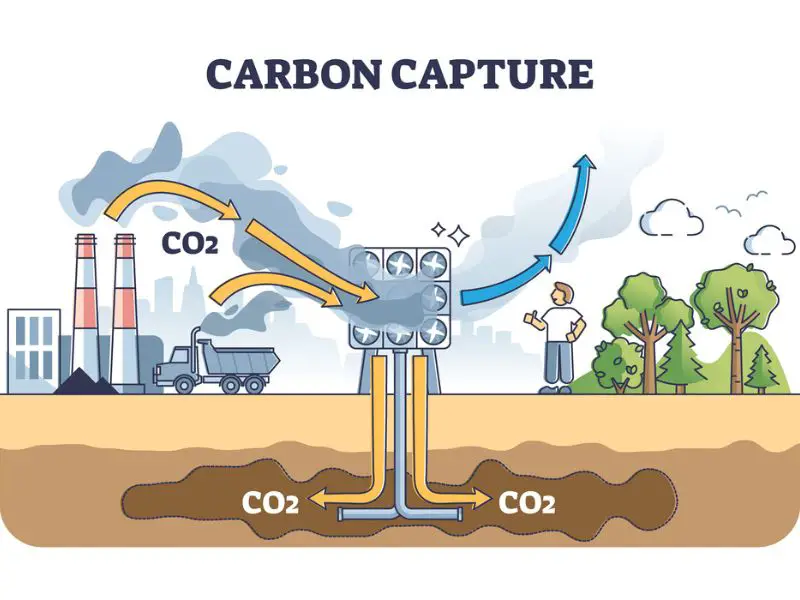Carbon capture is a technology used in many energy-intensive industries to reduce their carbon footprint and ensure compliance with climate change mitigation policies. The project’s goal is to capture and store the CO2 that would otherwise be emitted into our atmosphere.
In this article, I will tell you how carbon capture works, its purpose, history of its development, and its pros and cons.
A Quick History of the Technologies Behind Carbon Capture and Storage
The core concept of Carbon Capture is to trap CO2 and prevent its way into the environment by storing it safely underground. The technology was first proposed in 1977, using new technologies.
Since the 1920s, CO2 capture technology has been adopted to separate CO2 from saleable methane gas in natural gas reservoirs.
In the early 1970s, collected CO2 from a gas processing facility in Texas (United States) was sprayed into a nearby oil field to enhance oil recovery. This process, known as Enhanced Oil Recovery (EOR), has proven to be highly effective, and millions of tonnes of CO2 – both from natural CO2 accumulations in underground rocks and captured from industrial facilities – are now piped to and injected annually into oil fields in the United States and elsewhere.
What Is Carbon Capture and Storage?
Carbon Capture and Storage (CCS) is a method for lowering carbon emissions, which is crucial for combating global warming. It involves three steps:
- Capturing the carbon dioxide produced by electricity generation or industrial activities, such as steel or cement production.
- Transporting it.
- Storing it deep underground.
How Does Ccs Help the Fight Against Global Warming?
The Intergovernmental Panel on Climate Change (IPCC) pointed out that if we want to meet the goals of the Paris Agreement and keep future temperature increases below 1.5 degrees, we need to do more than just reduce our emissions. We also need to use technologies to take carbon out of the air. CCS is one of these technologies and it can help fight global warming.
3 CCS Steps
There are three basic steps for CCS:

1. Capture
The CO2 is separated from other gases created as a byproduct of industrial operations, such as those in power plants that burn coal or natural gas and factories that produce steel or cement.
2. Transport
The CO2 is transported to a storage site. The technology for transport could take many forms. Whether land or pipelines are the best technology to transport CO2 depends on several factors, including the size of the site and the specific application of capture.
3. Storing
The CO2 is injected deep underground for permanent storage. There are several CCS storage sites worldwide, including one in Canada that stores CO2 captured from an EOR site and another in Norway that stores CO2 from a natural gas processing facility.
Environment Benefits and Risks of CCS
Benefits
Storing carbon captured from power plants and underground industrial facilities presents an opportunity to reduce greenhouse gas emissions significantly.
With the support of governments, industries, and stakeholders, CCS can play a significant role in mitigating climate change. The challenge is to find an appropriate storage methodology and establish suitable monitoring and research programs – but it can be done.
- The procedure has been presented to reduce carbon emissions from fossil fuel power plants and other related industrial activities.
- According to a study conducted by R. T. J. Porter and colleagues, pre-combustion capture technology can trap between 50 and 98 percent of carbon dioxide.
- There are different methods to store CO2. These include storage in the deep ocean, storage in depleted oil and gas reservoirs, storage in underground rock formations, and storage in old oil and gas reservoirs.
Risks
Carbon capture and storage technology are not fully mature. As a result, much uncertainty exists over its long-term performance and environmental impact.
- Fossil fuel power plant owners and operators must consider the cost of capturing carbon dioxide.
- The risks associated with carbon capture and storage include the possibility of leakage into the environment, failure to meet the timetable for storing CO2, and potential damage to underground sources of drinking water.
- Natural disasters such as earthquakes and human-caused accidents might cause CO2 to leak from underground and reservoir storage.
- Deep ocean storage hasn’t been tested. Experts aren’t sure if the CO2 dumped on the ocean floor will stay there.
Trees Can’t Save Us
Trees are undoubtedly some of our most reliable allies in the fight against climate change and global warming. Because plants can take in and store carbon dioxide through photosynthesis, we may consider them all-natural carbon capture and storage systems.
Unfortunately, scientists believe there is no way to plant enough trees to counterbalance the excess CO2 that has been pushed into our atmosphere due to burning fossil fuels.
In addition, older forests with a greater diversity of tree species are better at capturing CO2 than younger, more homogenous forests.

Author’s Note
Scientists are working hard to improve carbon capture and storage technologies. Although we may not yet know the full extent of their effectiveness, what we do know is that they hold the potential to drastically reduce emissions into the atmosphere and become a cornerstone in our fight against climate change.
Carbon dioxide capture and storage (CCS) has been a goal of scientists, regulators, and some corporations since at least the 1920s. The use of CCS is currently limited by uncertainty about whether it will deliver its promised benefits while minimizing costs.
Related: Technological Solutions to Climate Change, Electric Cars, Disadvantages of Hydropower and Its Impact on the Environment

How much carbon has ACTUALLY been sent to reliable permanent (forever) underground storage?
Seems this is not even known.
Just capturing it, in order to sell it to be re-used, is NOT permanent storage. But so far it is the only way to make storing it profitable.
“Unclear guidance means there’s no international consensus on how much has been stored so far, save for academic calculations. We urgently need clearly defined parameters so we know exactly where we stand.”
Dr Samuel Krevor
Department of Earth Science and Engineering
https://www.imperial.ac.uk/news/238411/carbon-captured-stored-since-1996-significant/#:~:text=As%20of%202021%2C%20the%20global,across%2026%20operational%20CCS%20facilities.&text=No%20centralised%20framework%20exists%20globally,storage%20are%20not%20centrally%20reported.